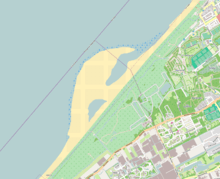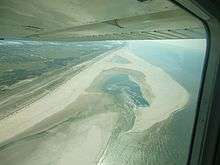Sand engine
The sand engine (also called Sand Motor) is an experiment in the management of dynamic coastline. The first one was run off South Holland in the Netherlands. A hook-shaped peninsula was created by humans; the surface is about 1 km². It is expected that this sand is then moved over the years by the action of waves, wind and currents along the coast. To protect the West of the Netherlands against the sea, the beaches along the coast are artificially replenished every five years, and it is expected that the sand engine will make replenishment along the Delfland Coast unnecessary for the next 20 years. This method is expected to be more cost effective and also helps nature by reducing the repeated disruption caused by replenishment.[1]

For the first time in 2011 at the request of the Hoogheemraadschap van Delfland as part of the coastal management and the maintenance of the coastline by the highways and the province of South Holland, a peninsula was created between Ter Heijde and Kijkduin, where natural beaches and dunes are relatively narrow.
In 2017 it was announced that another sand engine would be built in Norfolk, United Kingdom.[2]
Building with nature
Professor Marcel Stive is considered the inventor of the sand engine.[3] Another such project could provide a solution to the weak coast between Camperduin and Petten, which is called the Hondsbossche seawall. The experience of this first sand engine is interesting for future projects. The construction of the sand engine at Ter Heijde cost 70 million euros and is the first in the world of its kind. Joop Atsma, State Secretary for Infrastructure and Environment, presented the project in November 2011 and his purpose was to convince that the technique of sand engine could be useful on more locations along the Dutch coast.[4]

Delta Dune
The first such project was given the name Delta Dune.[5] Work began in January 2011. The conditions were favorable and thus the operation was completed in October 2011. A volume of 21 million cubic meters of sand covers an area of 128 hectare.
Bacton Gas Terminal
In 2017 it was announced that another sand engine would be constructed to protect the Bacton Gas Terminal and surrounding area in Norfolk, in the UK.[2]
References
- The Sand Motor Archived 2014-03-19 at the Wayback Machine, Rijkswaterstaat and the province of South Holland
- "Sand Engine to protect British coast - Ecoshape". Ecoshape. Retrieved 4 December 2017.
- "Archived copy". Archived from the original on 2015-01-12. Retrieved 2015-01-12.CS1 maint: archived copy as title (link)
- Atsma wil meer 'zandmotors', Cobouw, 24 November 2011
- DeltaDuin winnaar prijsvraag Zandmotor Archived 2012-05-10 at the Wayback Machine
External links
| Wikimedia Commons has media related to Zandmotor. |